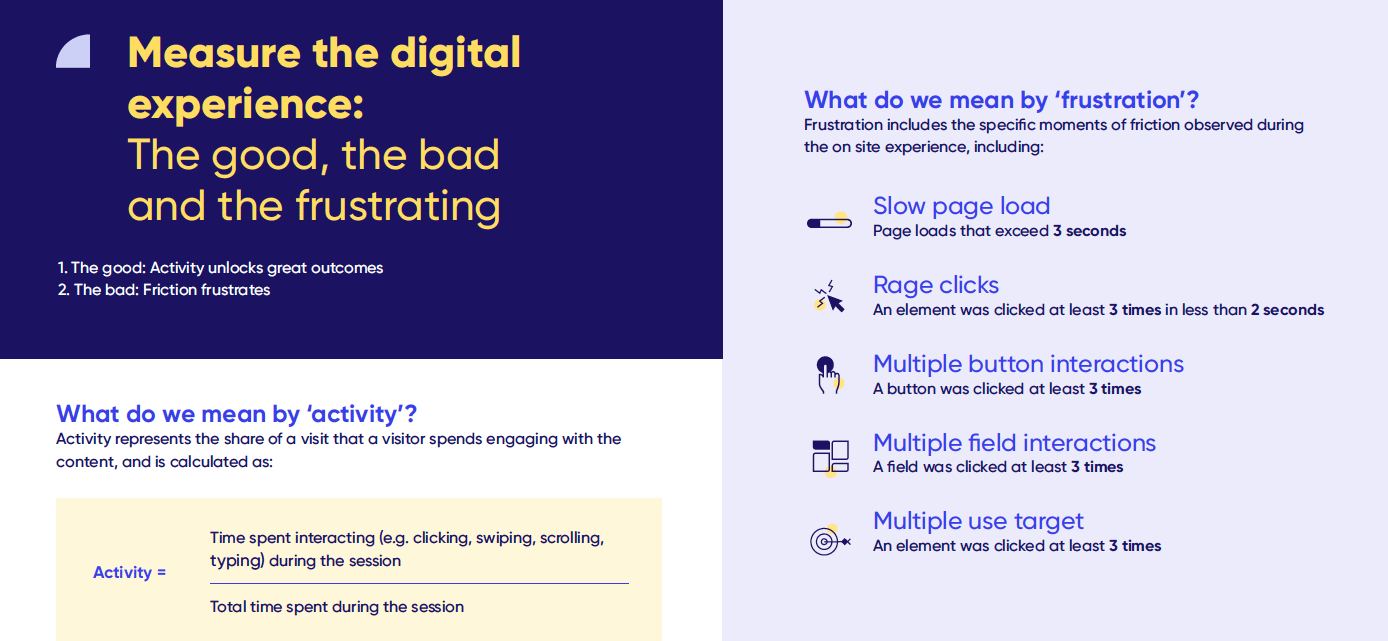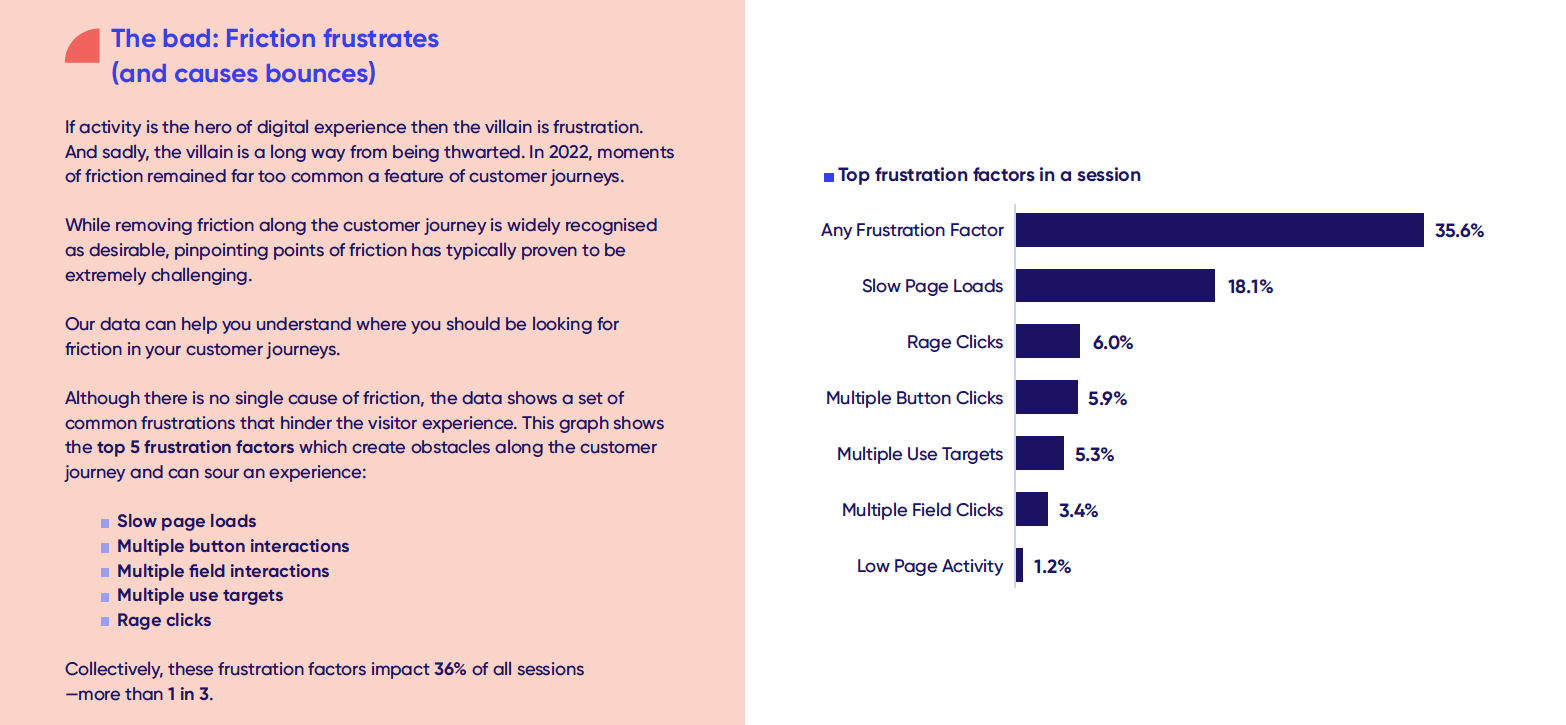Many brands are losing customers where it hurts most—when they’re trying to convert, particularly on mobile devices. Meanwhile, those that offer seamless cross-device CX, particularly on the top three high-trafficked website areas—product detail pages, category pages, and the checkout page—are experiencing the most significant digital outcomes: lasting customer interaction, a boost in online conversions, a significant reduction in bounce rates, and better overall website performance across both desktop and mobile devices, new research from digital experience analytics firm Contentsquare finds.
The firm’s 2023 Digital Experience Benchmark Report underscores the importance of engagement and dynamic experiences online, highlighting the areas brands must improve in order to bolster conversion and customer satisfaction.
Key benchmark highlights:
- Poor website performance is a real problem, with 36 percent of users reportedly having frustrating experiences on most websites—mostly attributed to slow page loads—leading to a sharp decline in engagement and retention.
- Rage clicks are another leading cause of frustration. This behavior, when users repeatedly click on the same area of a website, affects 6 percent of browsing sessions.
- However, high activity sites are driving better outcomes for businesses—including major boosts in conversions (+19 percent) and session depth (+47 percent), and a decrease in bounce rates (-20 percent)
- With activity tied to higher conversions, businesses should focus on improving engagement across the three most trafficked page types—product, category and checkout
- Sustained engagement is key to digital success, as buyers consume on average more than 20 pages of content before conversion. But data shows a concerning trend that overall consumer patience and consumption is waning: session depth (2) per visit has dipped -2.3 percent, and overall time per session dropped -7.5 percent year-over-year.
- Many brands are losing customers at the checkout page, especially on mobile devices: 19.7 percent of mobile visits include time spent on a checkout page, but mobile conversions overall have dropped more than -4 percent year-over-year. In contrast, 18 percent of desktop visits include a checkout page and overall conversions on the device have jumped nearly +3 percent year-over-year.
“Data shows that engaging experiences have better outcomes: deeper journeys, higher conversions and fewer bounces. But our data also shows that today, one in three customers is still having a frustrating experience online—often because of poor site performance,” said Jonathan Cherki, CEO & founder of Contentsquare, in the release. “People today expect more out of the interactions they have online. They want to be seen, heard, and responded to in meaningful ways. Optimizing digital content and creating seamless customer journeys is where you should focus to drive growth and retention.”
Give customers a reason to stay, convert, and return—best practices
Digital experience success is defined by three areas: capturing attention, reducing friction, and ensuring page content is relevant and seamless across the entire website. Merging paid channels and organic search to increase visibility, all the while prioritizing content that encourages interaction and engagement boosts the overall performance of a website.
The average visitor journey is not deep– ~5 pages per session at a 50 percent scroll rate—companies need to identify high performing content and pull these assets, offers and CTAs higher up on the page. Additionally, knowing which content is never seen and which under versus over-performs, enables teams to invest in content more effectively, while improving conversion rates.
Providing clear information with speed, obvious prompts directing customers to the next stage of their journey by signaling pathways for search and discovery, and ensuring content is aligned with their intent gives brands a clear competitive edge.
Blend experiences across devices
Seamless cross-device CX is a bigger priority than most brands realize and the importance of blended experiences is defining an emerging area of opportunity, according to the data. Consumers are exploring web pages through two primary devices – mobile and desktop—with conversion preferential to desktop. Browsing is typically relegated to mobile, where consumers ‘graze’ before making buying decisions. Fifty-five percent of all mobile traffic are new visitors, meaning losing customers due to poor CX can have a detrimental effect on revenue. While Checkout pages are still highly important for both desktop and mobile, mobile conversion rates are down year-over-year by -4 percent, and any attention paid especially to these final moments before conversion could minimize abandoned carts and frustrated customers.
Across devices, brands must prioritize delivering seamless end-to-end, tailored experiences that focus on customer value. A May 2022 consumer survey revealed 88 percent of customers say the experience a company provides is just as important as its products and services (3), an +18 percent increase from the year prior, proving that getting a customer to your website is only the beginning.
Lasting relationships are defined by understanding customer intent and desired experiences
Positive experiences don’t start and end with great products or prices, smart brands are uniquely tapping into emotions, too, focusing on bringing joy to the overall CX. Forrester Customer Experience index data from June 2022 cites “Elite brands…provide, on average, 15 percentage points more emotionally positive experiences compared to the rest of the field.”
The most trusted way to determine customer expectation, happiness, and satisfaction can be found in digital experience data. As customers evolve, so do their online behaviors, which are the breadcrumbs they leave that tell a bigger story–every click, scroll, search, mouse hover, page forward or backward, and time spent on a brand’s website are valuable insights for brands looking for meaningful ways to improve the digital experiences they deliver.
Download the full report here.
The year’s report is based on analysis of 35 billion sessions, and 161 billion page views across 2,942 global websites.






